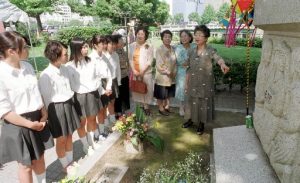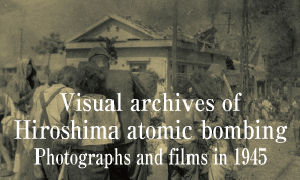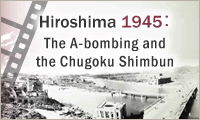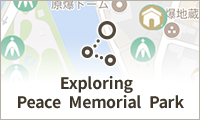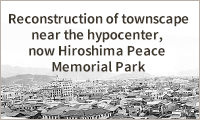Former students at Municipal Girls’ School break “silence” to communicate friends’ deaths in A-bombing as mobilized students
Aug. 6, 2000
“Feel guilty for surviving” while 277 classmates died
On August 5, five women who had been first-year students at Hiroshima Municipal First Girls’ High School (Municipal Girls’ School; present-day Funairi High School) at the time the atomic bomb was dropped on the city, together visited the right bank of Motoyasu River in Hiroshima’s Naka Ward, where a memorial monument for the A-bomb victims at Municipal Girls’ School stands, mourning the deaths of their 277 schoolmates. They had avoided publicity to that point out of “a sense of guilt for having survived the atomic bombing.” When meeting with younger students at the school who were working on preparations for a memorial service on August 6, the women broke their silence and shared their thoughts about the deceased classmates and described the area where they had experienced the bombing, calling on the current students “to pass on the history of the school, which suffered the most deaths of any school in the atomic bombing, to younger students.”
Eiko Sumida, 68, Toshiko Takagi, 68, Kumiko Tsuchimoto, 67, Yoko Tomoda, 67, and Kazuko Yoshida, 68, who all live in Hiroshima City, laid a flower wreath at the monument with a card on which was written, “From Hiroshima Municipal Girls’ School, 27th Class,” and offered sticks of incense.
First- and second-year students at Municipal Girls’ School had been mobilized to help with building-demolition work in the south side of the former Zaimoku-cho area, which now makes up Peace Memorial Park. A total of 541 students died in the atomic bombing.
Ms. Sumida and the other women were absent from work as mobilized students on the day of the atomic bombing because of family matters or illness. With mixed feelings after the bombing, each had only privately visited the school’s memorial monument to that point. With the Chugoku Shimbun’s project this year to compile a record of first-year students at the school who had been killed in the bombing, the group of women decided to get together and pay tribute to their deceased school friends.
“The day before the atomic bombing, amid heat similar to today’s, all of us cleaned up rooftiles with our small bodies, shouting, ‘Heave-ho,’” said Ms. Yoshida as she spoke to five second-year student council members at Funairi High School, who were engaged in the work of cleaning up the area around the monument. She experienced the atomic bombing at her home in Nishi Ward, 1.8 kilometers from the hypocenter, because she was taking care of her ailing mother.
On the day of the atomic bombing, Ms. Sumida was at her grandmother’s home on an outlying island. She said, “I nearly went crazy after hearing that my friends engaged in work had died in a way that prevented their bodies from being identified.” Ms. Tsuchimoto, who had been evacuated to Saeki Ward, and Ms. Takagi, who had been commuting to school from Asaminami Ward, reflected on the trauma they experienced at the age of 12 or 13, using few words. “At this spot, we searched for their personal belongings and brought them back to school.”
Ms. Tomoda, who was at home due to poor health, experienced the atomic bombing in Nishi Ward, around 1.2 kilometers from the hypocenter, losing her mother and younger sister, as well as the sight in her right eye. As if trying to persuade the students, she said, “I would like you to look back on your school’s history and thoroughly consider why the students the preceded you had to die.”
Hiroko Sakoda, 17, student council president, said, “We found we didn’t know much, including the fact that all of the students who had been mobilized to work died at the time of the atomic bombing. We will offer flowers during the memorial ceremony with thoughts of the former students in mind.”
(Originally published on August 6, 2000)

